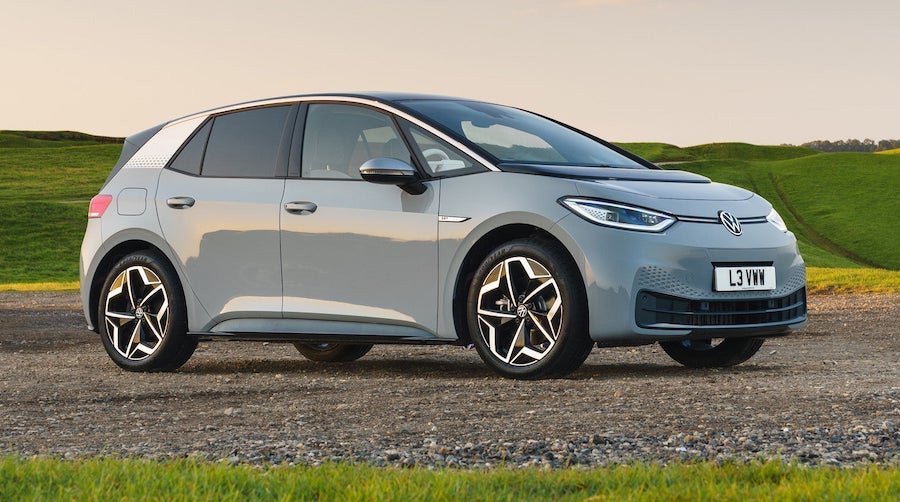Nearly new buying guide: Volkswagen ID 3

If you wish to gaze at the seeds of time and see which grains will grow, look no further than the Volkswagen ID 3. It’s tomorrow’s Golf, after all, and when it was launched in 2020 it was the flagbearer for Volkswagen’s industry-leading electric car offensive.
Now we have the ID 4, the ID 5, the ID 6 and the ID Buzz. It’s quite possible that soon there’ll be more IDs in the showrooms than there are IDs backstage at a Rolling Stones gig.
But it’s the ID 3 that arrived first and, given it’s an electric family car, it’s very likely that it will become VW’s future best seller. It’s built on a bespoke electric vehicle platform, has a drag-busting Cd of 0.27 and there’s not a petrol, diesel or hybrid in sight.
The entry-level battery choice is the Pure Performance 45kWh. It has a 148bhp motor that gives a claimed 0-62mph time of 8.9sec. Next up is the 58kWh battery, which is available with two power outputs: in Pro form it’s 143bhp, but if you opt for the Pro Performance variant it has 201bhp. Finally, the larger Pro S 77kWh battery powers the same 201bhp motor.
Life trim is sufficiently well equipped, and as standard you get a multifunction heated steering wheel, heated front seats, adaptive cruise control, powerfolding door mirrors, front and rear parking sensors and a 10.0in infotainment system.
Stepping up to Family trim introduces some useful extra equipment, including two-zone climate control, while Max trim gets all the goodies, including adaptive suspension and progressive steering as part of a Sports pack. It’s more expensive, though, even used, and so too is Tour trim, which is only available with the largest battery.
The ID 3 has an excellent turning circle and light steering, so manoeuvring it around town is a breeze. It doesn’t give much finger-tingling communication or weight build-up when cornering in the default Comfort driving mode, but if you select Sport you get a bit of useful extra heft.
A heavy battery requires a stiff suspension set-up to support it properly, so don’t expect the ID 3 to offer luxury car levels of ride comfort. It’s far from harsh, but around town in particular it’s choppy over potholes, and it frequently fidgets around on the motorway.
The interior of the ID 3 has a futuristic feel without being so revolutionary that it’ll scare anyone. There’s a digital pod behind the steering wheel with a small but clear 5.3in display that shows the speed, range and sat-nav instructions, and a rotary-style gear selector on the side. However, the interior quality overall is decidedly iffy, with plenty of cheap, hard plastics in evidence.
All ID 3s come with a 10.0in infotainment touchscreen, which is quite a bit smaller than the 15.0in display in the Tesla Model 3. Sadly, Volkswagen’s latest infotainment software is laggy and has a confusing layout, and it’s nothing like as slick as that of the Model 3.
Front and rear passenger space is excellent, with plenty of head and legroom available. The boot is about the same size as the one in the Golf, which is fine for the typical requirements of fitting in a buggy, the weekly shop or a couple of reasonably sized suitcases.
Need to know
Around £30k buys an early ID 3, most likely with 143bhp. Spend £31-35k on a 2020 or 2021 car, or £35-£45k on a 2022 model.
The Pure Performance 45kWh’s claimed range of 217 miles is more than the Volkswagen e-Golf could ever offer. With the 58kWh battery it rises to 226 miles; the Pro S 77kWh can do an impressive 336 miles.
The ID 3 can fast-charge at up to 100kW (125kW for the top model), getting the 58kWh battery from 10-80% charge in 30min. Most service station chargers are 50kW, so 60mins for a 10-80% charge. A 7kW home wall box should take nine hours for a full charge.
Buyer beware
Cabin quality: The car’s slightly unlovely cabin quality is our major gripe. It misses VW’s usual high-quality feel by some margin. We will grumble a the deficit of ‘real’ buttons, too. All the controls are touch-sensitive, including the temperature control sliders that don’t even illuminate at night. Everything else is operated from the central infotainment touchscreen, making it distracting to change anything on the move. Physical buttons and knobs – as found in many rival cars, including the Kia e-Niro – are so much easier to use.
Uninspiring drive: The competent but anodyne driving experience may be barriers to success at higher price points; the ID 3 is notably plain, dry and featureless to drive. The electronic management of the ID 3’s handling is sophisticated but also permanent: there’s no dialling back or switching off the ESC. Although we doubt if it would be more fun if you could turn it off anyway.
Top spec
Pro Performance 58kWh Life: As far as standard equipment is concerned, you’re pretty well covered even at the entry level. We’d recommend going for the ID 3 Pro Performance with the mid-sized battery and more powerful motor, and pairing it with Life trim.
Our pick
Pro Performance: The Pro Performance cars come with 201bhp and the 58kWh battery option. The combination gives plenty of poke and a decent range.
Wild card
Pro S Tour: The flagship ID 3 is unlikely to be the best seller in the range, but it packs a 77kWh battery for a 336- mile range, plus dual-zone climate, keyless entry, electric front seats and a rear-view camera.
